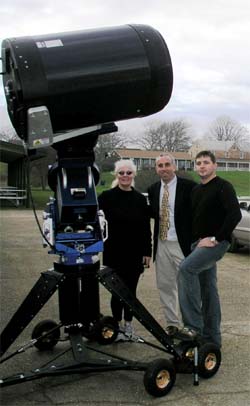
Susan Harder (dark-sky advocate), Jay Schneiderman (Suffolk County legislator), and Sean Tvelia (Suffolk County Community College) pose with Montauk Observatory's 20-inch Meade RCX400 telescope.
Source: Susan Harder
One look at a nighttime satellite view of the Northeast Corridor, and you're convinced that finding a dark-sky site would be nearly impossible anywhere between Boston and Washington. But look again: the eastern tip of Long Island is remarkably dark. And thanks to citizen efforts in that region, light pollution is being controlled and a grand new public observatory is taking shape.
Years of effort by local residents culminated on November 20th when supporters of the fledgling Montauk Observatory showed off their crown jewel: a 20-inch Meade RCX400 telescope. Valued at $35,000 and weighing 500 pounds, the big scope will become the centerpiece of a planned $500,000 public and research facility in Theodore Roosevelt County Park, near East Hampton on Long Island's easternmost finger of land.
The park is already popular with the island's amateur astronomers. Although it's within 100 miles of New York City, Montauk Observatory is surrounded on three sides by open water and by Lake Montauk to its west. Not far away, across Gardiners Bay in Southold, is another large public observatory at the Custer Institute.
Neal DeGrasse Tyson, director of New York's Hayden Planetarium, visited the site last year and commented, "In my whole life, over the entire stretch between Washington, DC, and Boston, I’ve never seen the Milky Way at night until I came out here to the tip of Long Island, and I looked up and said, “It’s there!”
Spurred by resident Susan Harder and other local dark-sky advocates, the East Hampton area has become a hotbed of anti-light-pollution activity. In 2003 the Long Island Power Authority announced its plan to use only fully shielded outdoor lighting at its facilities and kicked off a program to encourage its customers to do the same. The next year East Hampton adopted a tough new lighting ordinance, and soon the tip of Long Island became an officially recognized "Dark Sky Park," the first in New York State.
 0
0
Comments
You must be logged in to post a comment.